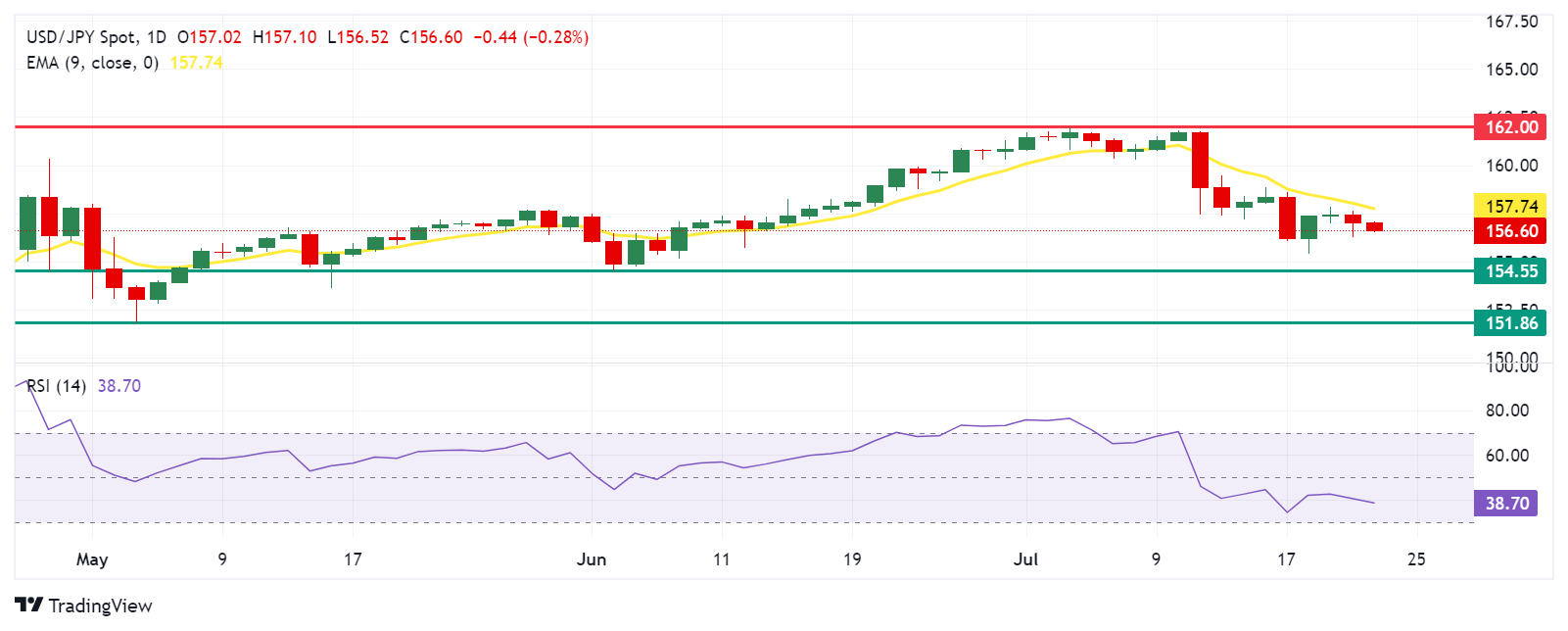- The Japanese yen extends gains as traders expect the BoJ to raise rates next week.
- Toshimitsu Motegi, a senior ruling party official, urged the BoJ to communicate its plan to normalize monetary policy.
- Media reports indicate that Vice President Kamala Harris has now surpassed 1,976 Democratic delegates, securing the party’s presidential nomination.
The Japanese Yen (JPY) extends its gains for the second consecutive session on Tuesday, which could be attributed to rising risk aversion. Traders are assessing the Bank of Japan (BoJ) interest rate decision next week, where a rate hike could be on the cards to support the JPY.
Toshimitsu Motegi, a senior ruling party official, urged the Bank of Japan (BoJ) to communicate more clearly its plan to normalize monetary policy through gradual interest rate hikes, noting that excessive falls in the yen were negatively affecting the economy, according to Reuters. Prime Minister Fumio Kishida added that normalizing the central bank’s monetary policy would support Japan’s transition to a growth-driven economy.
The USD/JPY pair is facing challenges as the US Dollar (USD) struggles due to rising bets for a Federal Reserve (Fed) rate cut in September. Federal Reserve (Fed) Chairman Jerome Powell noted that he is becoming more optimistic about the progress of inflation in recent months. Meanwhile, Fed Governor Christopher Waller stated that the time to lower the policy rate is getting closer.
Daily Market Wrap: Japanese Yen Gains Ground on Rising Aversion
Media reports say Vice President Kamala Harris has just surpassed 1,976 Democratic delegates to secure the party’s presidential nomination. Harris is now the presumptive Democratic Party nominee for the November presidential election.
Federal Reserve Bank of New York President John Williams said Friday that the long-term trends that caused neutral interest rates to decline before the pandemic continue to prevail. Williams noted, “My own Holston-Laubach-Williams estimates for r-star in the U.S., Canada, and the euro area are all roughly at the same level as before the pandemic,” according to Bloomberg.
Japan’s national Consumer Price Index (CPI) for June held steady at 2.8%, matching the previous month’s figure and remaining at the highest level since February. Meanwhile, core CPI inflation rose to 2.6%, slightly above the previous reading of 2.5% but just below the consensus estimate of 2.7%.
JP Morgan has anticipated that there will be no rate hike from the Bank of Japan (BoJ) in July or at any point in 2024. A rate hike in July is not their base case, and they do not expect any rate hikes for the rest of 2024. They believe it is too early to take a bullish stance on the Yen.
Kazushige Kamiyama, a senior official at the Bank of Japan (BoJ) and manager of the central bank’s Osaka branch, said on Thursday that the BoJ wants to maintain an accommodative monetary environment as much as possible, according to Jiji news agency.
During an interview with Bloomberg News on Tuesday, Donald Trump warned Fed Chair Jerome Powell against cutting U.S. interest rates ahead of the November presidential vote. However, Trump also indicated that if re-elected, he would allow Powell to complete his term if he continued to “do the right thing” at the Fed.
Last week, BoJ data suggested that policymakers may have intervened by buying nearly 6 trillion yen on July 11 and 12. In addition, data revealed that Japan sold about $22 billion of U.S. Treasury bonds in May to raise dollars, bolstering its reserves for potential currency market trades, according to Reuters.
Technical Analysis: USD/JPY drops near 156.50
USD/JPY is trading around 156.60 on Tuesday. The daily chart analysis shows that the pair is below its nine-day exponential moving average (EMA) of 157.75, suggesting bearish momentum in the near term. Additionally, the 14-day Relative Strength Index (RSI) is below 50, reinforcing a bearish outlook.
The USD/JPY pair could find significant support near the June low of 154.55. A drop below this level could lead to a further decline towards the May low of 151.86.
On the upside, immediate resistance lies at the nine-day EMA of 157.75. A break above this level could push the USD/JPY pair towards resistance around the psychological level of 162.00.
USD/JPY: Daily Chart
Japanese Yen PRICE Today
The table below shows the Japanese Yen (JPY) exchange rate against major currencies today. The Japanese Yen was the strongest currency against the New Zealand Dollar.
| USD | EUR | GBP | JPY | CAD | AUD | NZD | CHF | |
|---|---|---|---|---|---|---|---|---|
| USD | -0.04% | 0.02% | -0.42% | 0.03% | 0.05% | 0.10% | -0.04% | |
| EUR | 0.04% | 0.06% | -0.36% | 0.07% | 0.10% | 0.16% | -0.00% | |
| GBP | -0.02% | -0.06% | -0.42% | 0.02% | 0.03% | 0.10% | -0.06% | |
| JPY | 0.42% | 0.36% | 0.42% | 0.45% | 0.44% | 0.48% | 0.34% | |
| CAD | -0.03% | -0.07% | -0.02% | -0.45% | 0.00% | 0.04% | -0.08% | |
| AUD | -0.05% | -0.10% | -0.03% | -0.44% | -0.00% | 0.04% | -0.10% | |
| NZD | -0.10% | -0.16% | -0.10% | -0.48% | -0.04% | -0.04% | -0.14% | |
| CHF | 0.04% | 0.00% | 0.06% | -0.34% | 0.08% | 0.10% | 0.14% |
The heatmap shows percentage changes of major currencies. The base currency is selected from the left column, while the quote currency is selected from the top row. For example, if you choose the Japanese Yen from the left column and move along the horizontal line to the US Dollar, the percentage change shown in the chart will represent the JPY (base)/USD (quote).
Japanese Yen FAQs
The Japanese Yen (JPY) is one of the most traded currencies in the world. Its value is determined broadly by the performance of the Japanese economy, but more specifically by the policy of the Bank of Japan, the spread between Japanese and US bond yields, and risk sentiment among traders, among other factors.
One of the Bank of Japan’s mandates is currency control, so its moves are key to the Yen. The BoJ has intervened directly in currency markets on occasion, usually to lower the value of the Yen, although it often refrains from doing so due to political concerns of its major trading partners. The BoJ’s current ultra-loose monetary policy, based on massive stimulus to the economy, has caused the Yen to depreciate against its major currency peers. This process has been exacerbated more recently by a growing policy divergence between the BoJ and other major central banks, which have opted to sharply raise interest rates to combat decades-old levels of inflation.
The Bank of Japan’s stance of maintaining an ultra-loose monetary policy has led to an increase in policy divergence with other central banks, in particular with the US Federal Reserve. This favours the widening of the spread between US and Japanese 10-year bonds, which favours the Dollar against the Yen.
The Japanese Yen is often considered a safe haven investment. This means that in times of market stress, investors are more likely to put their money into the Japanese currency due to its perceived reliability and stability. In turbulent times, the Yen is likely to appreciate against other currencies that are considered riskier to invest in.
Source: Fx Street
I am Joshua Winder, a senior-level journalist and editor at World Stock Market. I specialize in covering news related to the stock market and economic trends. With more than 8 years of experience in this field, I have become an expert in financial reporting.








